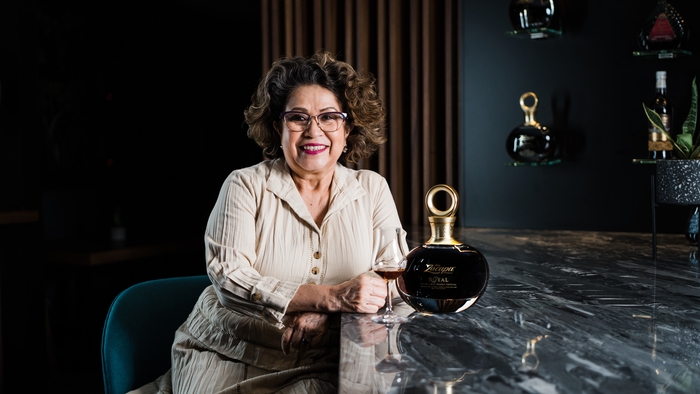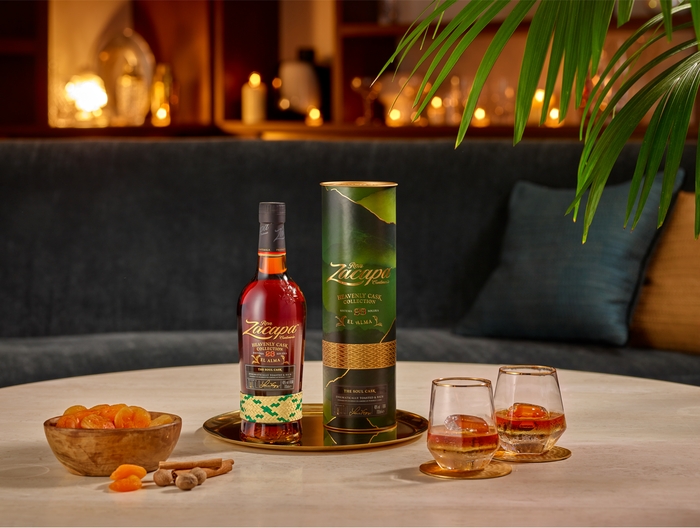
Ana Lorena Vásquez Ampié was born in Nicaragua, and began her career at Zacapa, Guatemala , in 1984. With a degree in chemistry and food technology, she naturally started in the quality control department. But her interest quickly turned to aging, where she was able to put her technical background and especially her innate gift for tasting to good use.
Surrounded by men, she initially had to face the skepticism of her colleagues, who were forced to recognize her unique skills. She thus climbed the ladder within the distillery, to bring her ideas and innovate, so that Zacapa rum would experience the success it has today.
We had the chance to meet and talk with Lorena, particularly about the brand new Zacapa El Alma rum which has just arrived in France.
You are known to be a gifted taster, with particularly developed senses of smell and taste. Is this a gift you were born with or something you worked on later?
I have always had this curiosity for aromas. I developed it later, but I have had it since I was little. In fact, at the time it was very complicated for me. When I sat down at the table, and there was something I didn't like, I simply couldn't eat it. My father, who was a doctor, would tell me "Lorena, eat, eat, eat!", and I couldn't leave the table until I had finished.
Is this something you still work on today, in order to evaluate rums?
Yes, it is always important to practice, and especially to know your own aroma detection thresholds. Ultimately, in sensory analysis, the person is the instrument. It is therefore important to calibrate this instrument.
Do you have any advice to give to a rum lover, to help them taste better ?
You can start by going into a kitchen, and recording all the aromas that you come across. This is important, because often you find an aroma, you know it's there, but you don't know how to identify it, you don't know how to put a name to it. So it's good to practice again and again, in order to record it.
It is said that women are generally better tasters than men...
That's true, and there's a physiological reason for that. Also, I think you have to be particularly focused when you're doing a sensory evaluation, and you're more used to that exercise as a woman.
Is it this sensitivity that led you to do the studies you did, then your current job?
I think so. When I went to school and later to university and studied chemistry, elements, I was particularly interested in sensory analysis. It was something that I really enjoyed. It seemed easy to me. I always said that I would like to work in something that had to do with aromas and flavors.
Such sensitivity makes it possible to associate a mental image with an aroma and therefore with a molecule…
Absolutely, when I perceive an aroma, my brain visualizes it in three dimensions. This makes the work easier indeed!
When you started working at Zacapa , there were very few women working in the sector, was that complicated?
At the time, at the distillery, there were "200 men and Lorena", so it was a bit complicated. It got better later. In any case, today it's going very well! (laughs)
The Zacapa and Botran brands both come from the Ingenio Tulula distillery. When do their manufacturing processes differ?
In fact, both brands are produced on the same site, in the same distillery, but they have big differences. They are distinguished from the first stages of production. From the cane point of view, we have early varieties that are ready at the beginning of the harvest season, intermediate varieties, and late varieties. The canes that we use for Zacapa are early varieties, while Botran uses late varieties. Therefore, the fermentations are different, because the raw material is not the same.
In addition, each rum has its own team, the distillation column is different, and the aging is completely different.
Given that Zacapa ferments and distills cane honey, is this cane grown exclusively for rum?
Mostly yes, but some of our plantation is also used to produce sugar. Cane honey is concentrated cane juice. Each ton of cane produces 32 gallons (about 120 liters) of virgin honey. It is very important to know that if you use cane to produce sugar, you cannot produce virgin honey, and vice versa.
When sugar is produced, honey is actually produced first. This passes into another container for crystallization, then into a centrifuge to separate the sugar crystals from the molasses.
Cane honey for rum is different from that for sugar, because for the latter the juice is cooked at a higher temperature. There is more caramelization, and that makes things a little more bitter. You retain more of the cane's aromas with a gentler cooking.
The difference also lies in the fact that the variety of sugar cane used is not the same.
Do you still use yeast made from pineapple skins?
Yes, it's not that we put pineapple to ferment, it's a yeast that is on the skin of the pineapple, that we have taken. At the moment, it is developed in the laboratory, but we regenerate it regularly with pineapple juice.
Today your title is Maestra Ronera de Zacapa? Does your role consist of supervising the entire production, from cane to bottling?
Yes, over the years, I have come to be called that. My responsibility begins with the control of the cane varieties, then the production of the honey on which I do a sensory analysis. I also test the distillation samples, but the bulk of my work is in the cellars, with the blends. We are always blending the rums , with several stages. This is my favorite part, also because it is the part where the human aspect is most present.
Do you work in the Cuban way, with blends of light rums and aguardientes?
No, we work differently. The Cubans first make an aguardiente to which they add sugar, and which is then assembled to make the rum. We only make one type of distillate that is between 88 and 92% alcohol, which we reduce to 60% before putting in the barrel, that's all. At the end of the distillation process, we look for a rum with a complexity of aromas and flavors that is in the profile that we have defined.
Can you remind us of the typical aging process of Zacapa rums?
We start the aging process at 60% alcohol in barrels that have contained American whiskey. We then blend with older rums and change barrels. This time, they are American whiskey barrels that we have re-burned. At the end, we blend again with older rums, which have gone through the four stages, and we pass them into ex-sherry oloroso barrels. Then we move on to the fourth and final type of barrel, which is the Pedro Ximenez sherry barrel. Finally comes the final blend. This is the generic aging process, for the Zacapa 23 , then there are variations depending on the different vintages.
Precisely, the El Alma vintage has just been released, what is its special feature?
This goes through 5 different types of barrels. In the last stage of aging, we make a completely different blend from the other vintages. We want to bring out spicy and woody notes, toffee, toasted almonds…
I feel a fresher side, compared to what I knew so far of Zacapa…
Absolutely, the freshness comes from the fact that the rum reaches the soul ("El Alma") of the barrel. This is possible thanks to a deeper toasting. Precisely, the fifth type of barrel used for the final blend is the same as the one used in the second stage, that is, the re-toasted American whiskey barrel. For the Zacapa La Doma , it was the first barrel of the process that was used. This Heavenly Cask collection is a tribute to the types of barrels that are used for aging.
This is a fairly smooth rum. Do you use anything to round it out?
No, the sweetness is provided by the Pedro Ximenez barrel, which is very round.
Do you have very old rums in your cellars that are not blended?
Yes, we have rums over 40 years old.
Do you use them as concentrates, as enhancers for blends?
No, for now we are keeping them in reserve for the day we need them.
Only aging above the clouds can allow this…
Yes, at sea level, after 14 years, the barrel is barely half full.
It was you who made the decision to move the aging cellars to altitude…
Yes, as well as adopting the dynamic solera system.
Have you studied this principle in the bodegas of Jerez?
No, not really, I visited the bodegas of course, but I mostly read a lot on the subject.
I guess to get so many sherry barrels you have to have good relationships with the bodegas…
Indeed, but you should know that the company has been buying these barrels for many years, so we have regular suppliers. Occasionally, we take advantage of the possible closure of a bodega to acquire barrels, even if we do not necessarily need them at the time.
To keep the very round side of the PX, do you always have to have freshly emptied barrels, or do they still give roundness after several years of use?
A barrel of PX is well coated with liquid thanks to the viscosity of this type of wine, but also, the old barrels have had time to be deeply penetrated by the liquid.
What does a typical work day look like for you?
In the morning, I start with the administrative part, taking inventory, answering emails, following up on projects… In the middle of the morning, we start tasting the samples. You shouldn’t start too early. Once you’ve eaten, you can’t taste before a two-hour delay. In the afternoon, it’s the same thing, I start with an administrative part, then I tackle the blends and sensory evaluations.
Some days, in the morning, I also taste the distillates that come out of the column. I don't taste them all, because there are a lot of batches, the distillery runs 24 hours a day.
I read that you are currently preparing your succession. How can you pass on know-how that is not always tangible?
This is a part I don't really know how to go about. I can teach the technique of evaluation, analysis, but for the creative part it's complicated. For example, how do you teach the ability to know what a rum will be like in 5 years?
It is therefore necessary to prepare the next generation well in advance; only experience can teach you this...
Yes, I have been training Maria for 15 years, for example.
Do you have any advice for a young woman who would like to study or work in an environment usually reserved for men?
For me, perseverance is super important. You have to be aware that nothing is easy, even if today's youth would tend to think that it is. Above all, you have to be curious, always ask yourself why. That's how you constantly progress in the professional field. Without that, if someone tells you "white", you say "okay it's white", and if someone tells you "black", you say "ok it's black". It's easier, it's reassuring, but it's much less interesting.
You are also a great lover of gastronomy, did you have time to take advantage of your stay in Paris to visit some restaurants?
No, not at the moment, although we were lucky enough to have three exceptional meals prepared by a Michelin-starred chef. But I really like coming to eat in Paris. I have my list of restaurants!






